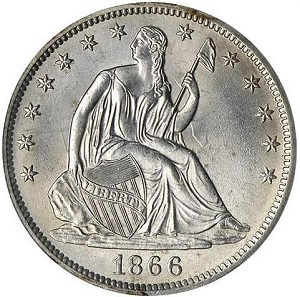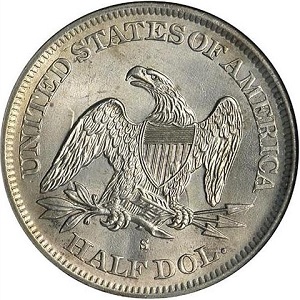1866-S Seated Liberty Half Dollar, No Motto
As death and destruction ravaged the nation during the Civil War, people increasingly relied on their faith in the Almighty for divine guidance. In response to the piety sweeping the country, the motto IN GOD WE TRUST appeared for the first time on a United States coin, the 1864 Two-cent piece.(1)
Apparently, the prayerful proclamation was well received by the public. On March 3, 1865, President Abraham Lincoln signed into law a coinage act, which among other things, authorized gold and silver coins of sufficient physical size minted after January 1, 1866, to carry the IN GOD WE TRUST motto on the reverse.(2)
As usual, dies for 1866 were fabricated at the mother mint in Philadelphia. Before the first of the year, the obverse dies arrived at the branch mint in San Francisco. It wasn’t until March before the new “With Motto” reverse dies arrived on the west coast.
While waiting for the new dies to arrive from Philadelphia, the San Francisco Mint paired the new 1866 obverse with the old 1865-S reverse to produce 60,000 “No Motto” half dollars sometime between January 1 and March 17 of 1866.(3)
Limited numbers of “No Motto” gold $5 half eagles, $10 eagles, and $20 double eagles were also struck at the “S” Mint as well.
When the new dies finally arrived, they were put into production immediately and churned out 994,000 “With Motto” 1866-S Seated Liberty half dollars.(4)
The population of 1866-S No Motto half dollars were quickly absorbed into the coin-happy American West, where approximately 99% of them succumbed to attrition.(5)
The scarcity across the board in all grades for the 1866-S No Motto Seated Liberty half dollar has made it a favorite of collectors for at least a century. Had it not been for a slump in recent years this coin would have been placed in a higher recommendation category.
Pay attention to this date in Mint State condition. PCGS estimates only 10 examples exist in grades MS-60 and higher,(6) yet price performance since 1975 has been comparatively flat. A sleeper indeed!
| Estimated survivors in all grades: 600 ?
The survivor estimate from PCGS represents an average of one or more experts' opinions as to how many examples survive of a particular coin in all grades. Survival estimates include coins that are raw, certified by PCGS, and certified by other grading services. Learn more at PCGS. |
| PCGS Rarity Scale: 5.8 ?
The 'PCGS CoinFacts Rarity Scale' assesses the relative rarity of all U.S. coins, based on estimated surviving examples. The scale runs from 1.0 to 10.0. The higher the number, the rarer the coin.
Learn more at PCGS. |
| Click HERE to check for availability on eBay** |
Preview of eBay selection:
 |
 |
| Trendline Avg = 11.97 | CLASSIC RARITY |
Historic Value Trend Charts:
| Last updated 5-11-24 | Return to Key Date Coin List | |
| Compare to Common Date Coin of Same Type | ||
|
|
||
| Download Charts to Your Computer | ||
Sources
1. NGC. History of the Shield Two Cents.
2. Heritage Auctions. 1866-S 50C No Motto. Nov 2013 Auction.
3. Stack's Bowers Galleries. 1866-S Seated Liberty Half Dollar. No Motto. Oct 2011 Auction.
4. Heritage Auctions. 1866-S 50C No Motto. Nov 2013 Auction.
5. PCGS. 1866-S 50C No Motto (Regular Strike).
6. PCGS. 1866-S 50C No Motto (Regular Strike).
**Many very fine coin dealers sell on eBay. At any point in time, there may be over one million search results for United States coins. This includes quite a few of the recommendations on our Key Date Coin List.
If you’re thinking about purchasing a rare coin, eBay is certainly worth a look. For your convenience, the links from this site to eBay are coded to bring up only coins certified by PCGS and NGC.
As is always, always the case, never buy a valuable coin from a seller whose trustworthiness cannot be verified. Learn more about this at our chapter Best Places to Buy Coins, which also has a section on doing business on eBay.
In the interest of full disclosure, Rare Coins 101 receives a small commission anytime someone connects to eBay from this site and purchases something.
Coin images by Stack's Bowers Galleries.


